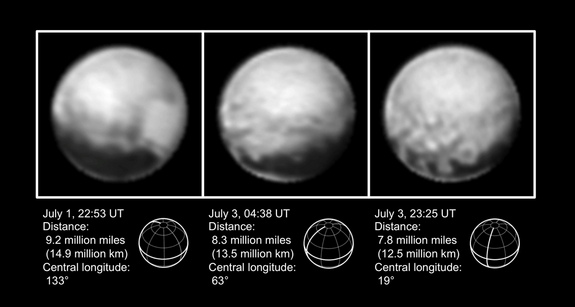New photos by NASA's New Horizons spacecraft show Pluto in tantalizing detail, whetting researchers' appetite for the probe's highly anticipated flyby of the dwarf planet next week.
The images reveal a great deal of variation and complexity across Pluto's surface — including the four large dark patches near the equator first spotted by New Horizons late last month.
The origin and composition of the dark blotches remain mysterious, adding to the intrigue building ahead of the July 14 flyby.

"This object is unlike any other that we have observed," New Horizons principal investigator Alan Stern, of the Southwest Research Institute in Boulder, Colorado, said during a news briefing today (July 6). "Both Pluto and Charon [its largest moon] are already surprising us."
New Horizons captured the new photos last Wednesday (July 1) and Friday (July 3), shortly before suffering a glitch that sent it into a precautionary "safe mode" on Saturday (July 4).
The problem arose because New Horizons was trying to do two things at once on Saturday — compressing lots of science data and burning into the primary computer the "command load" for the spacecraft's nine days of flyby operations, mission officials said.
"The two were more than the processor could handle at one time, so the processor says, 'I'm overloaded,'" said New Horizons project manager Glen Fountain, of the Johns Hopkins University Applied Physics Laboratory in Laurel, Maryland.
The team lost contact with New Horizons for more than an hour on Saturday, but once communications were restored, it quickly became clear what the problem was, Fountain said.
The spacecraft's handlers shepherded it out of safe mode on Sunday (July 5). New Horizons is healthy and ready to execute the nine-day flyby sequence, which begins on Tuesday (July 7), Fountain added.
Team members decided to focus on recovery and getting New Horizons ready for flyby operations, so the probe hasn't gathered any science data since entering safe mode on Saturday. As a result, New Horizons won't make 30 or so of the 496 observations planned from July 4 through July 16 — but the impact on the mission's science return will be negligible, Stern said.
"We can say that there is zero impact to the Group 1 — or highest-priority — science [objectives for the mission]," Stern said, adding that there will likely be minor gaps in several Group 2 and Group 3 objectives. "This is a speed bump in terms of the total return that we expect from this flyby."
The team isn't worried that the anomaly will recur during the close approach, because New Horizons won't be performing the two procedures involved concurrently again, Fountain said.
Further, the probe has already been in "encounter mode" multiple times during its long flight to Pluto, for preparation purposes. In fact, New Horizons rehearsed the full nine days of close-approach operations back in 2013, Stern said.
"So there's not a new operation tomorrow," he said. "I'm not worried at all about going into encounter mode tomorrow."
The $700 million New Horizons mission launched in January 2006. During the July 14 flyby, the probe will zoom within 7,800 miles (12,500 kilometers) of Pluto, capturing the first-ever up-close looks at the dwarf planet.











